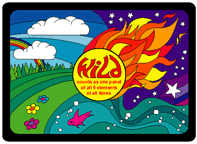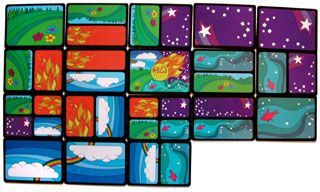The
Aquarius
Challenge!
Yes, in fact, you CAN try this
at home...
|

back2
Orts |
back to the
top of Alison
 |

back2
W/land |
 Take
out your Aquarius
deck. You'll also need an Aquarius wild card, only available
in NanoBlanks
(but you can substitute a good imagination for that if you have
to). If you're reading this, and don't know the
basic rules to Aquarius, you'll probably want to check them
out before proceeding.
Take
out your Aquarius
deck. You'll also need an Aquarius wild card, only available
in NanoBlanks
(but you can substitute a good imagination for that if you have
to). If you're reading this, and don't know the
basic rules to Aquarius, you'll probably want to check them
out before proceeding.
The first thing to keep in mind is that the wild card counts
as a full panel of all five elements at all times. You don't pick
which one it is when you play it. That would be annoying -- everyone
would have to remember which it is, and there's no convenient
way to mark it. Besides, it's much more fun this way.
Now, since it's all elements at once, it can benefit multiple
players, and, indeed, could cause a win for more than one player
simultaneously. Of course, if you played a multi-panel card just
right, I suppose you could do this too... But only with
the wild card could you theoretically play the seventh card for
ALL FIVE elements at the same time!
Wow!... Cool!... Now... how few cards can you do it with?
The Challenge:
Try to create a layout such that all five elements win with
exactly seven panels with the play of a single wild card, and
try to do it using as few cards as possible (and, as a secondary
goal, trying to have as few "wasted" panels as possible).
 |
Here's my best solution: 18 cards, 2 unused
panels: the small quarter-panel of stars in the lower left,
and the small quarter-panel of earth in the lower center. Those
four-square cards are hard to use, but when you can use them
well, they're very effective. It's true that some of those full-panel
single element cards could have been replaced by double-panel
or four-squares, but then there would have been more wasted panels,
and that's just inelegant. |
There you have it. Grab your Aquarius deck and go for it. I
found this a very satisfying solitaire challenge, and I just had
to wonder what some other solutions might look like, and whether
they could get smaller than this.
Send me e-mail
with a picture, link to a picture online, or description of your
layout (have fun trying to figure out how to effectively describe
the cards if you don't have a way to send a picture-- but hey,
if you can create it, I'm sure you can come up with a way to get
it across.)
So far, I have received several solutions from Elliot
Evans, some larger, some equal to or smaller than my example
layout. Our e-mail correspondence resulted in some interesting
analysis of the puzzle, which is included on the solution
page.
For those of you who'd like know some of the observations and
questions that arose from his submissions, without seeing his
layouts, I've tried to distill out some discussion
points and questions. The discussion points are actually more
mentally challenging than the commentary, which I guess makes
sense.
| --- Copyright © 2004 by Alison
Frane --- |
 Take
out your Aquarius
deck. You'll also need an Aquarius wild card, only available
in NanoBlanks
(but you can substitute a good imagination for that if you have
to). If you're reading this, and don't know the
basic rules to Aquarius, you'll probably want to check them
out before proceeding.
Take
out your Aquarius
deck. You'll also need an Aquarius wild card, only available
in NanoBlanks
(but you can substitute a good imagination for that if you have
to). If you're reading this, and don't know the
basic rules to Aquarius, you'll probably want to check them
out before proceeding.
